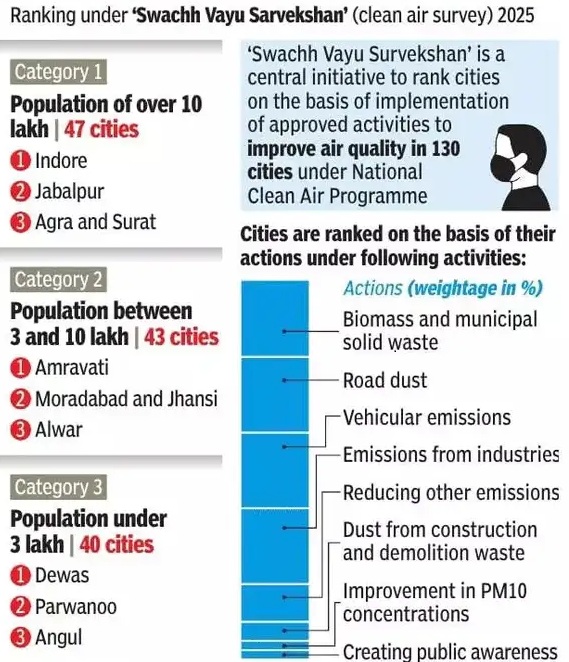Why in the News?
Indore, already recognized as the cleanest city in India, has topped the list of million-plus population cities in the Swachh Vayu Survekshan 2025.

About Swachh Vayu Survekshan (SVS), 2025:
- Overview: Annual survey by the Ministry of Environment, Forest and Climate Change (MoEFCC) under the National Clean Air Programme (NCAP).
- Objective: Promotes healthy competition among cities and accelerates implementation of air quality measures.
- Coverage: Includes 130 cities, grouped into 3 categories: million-plus population, 3–10 lakh population, and under 3 lakh population.
- Parameters: Cities assessed on 8 factors such as road dust mitigation, solid waste management, vehicular emission control, industrial emission control, construction and demolition waste handling, public awareness, and particulate matter (PM10/PM2.5) reduction.
- Methodology: Uses a multi-tier evaluation focusing on both on-ground actions and measurable outcomes.
Key Findings of SVS, 2025:
- Top Performer: Indore ranked 1st among million-plus cities, regaining its position after slipping to 6th in 2024. It had also topped in 2023, while Lucknow topped the inaugural edition in 2022.
- Other Million-Plus Rankings: Jabalpur 2nd, Agra and Surat 3rd, Navi Mumbai 4th, Kanpur 5th, Bhopal 6th, Allahabad 7th, Chandigarh 8th, Ahmedabad–Pune–Nagpur 10th, Varanasi and Raipur 11th, Lucknow 15th, Hyderabad 22nd, Mumbai 25th, Jaipur 26th, Delhi 32nd, Bengaluru 36th, Kolkata 38th, Chennai 41st.
- 3–10 Lakh Cities: Amravati 1st, Jhansi and Moradabad joint 2nd, Alwar 3rd.
- Under-3 Lakh Cities: Dewas 1st, Parwanoo 2nd, Angul 3rd.
- Air Quality Data: Indore recorded PM10 at 83 μg/m³ in 2024–25, slightly higher than 82 μg/m³ in 2017–18. Cities like Chennai (58 μg/m³), Varanasi (59 μg/m³), Bengaluru (68 μg/m³), and Hyderabad (81 μg/m³) showed lower PM10 levels than Indore.
- Overall Trends: 103 of 130 cities reduced PM10 since 2017–18. 64 cities achieved a 20% reduction, while 25 cities achieved a 40% reduction. Only 22 cities met the national standard of ≤60 μg/m³, with Chennai the only metro (58 μg/m³). Among metros, Mumbai recorded the highest decline (44%), followed by Kolkata (37%), Hyderabad (26%), Bengaluru (26%), Delhi (15%), and Chennai (12%).
| [UPSC 2022] In the context of WHO Air Quality Guidelines, consider the following statements:
1. The 24-hour mean of PM 2.5 should not exceed 15 μg/m3 and annual mean of PM 2.5 should not exceed 5 μg/m3. 2. In a year, the highest levels of ozone pollution occur during the periods of inclement weather. 3. PM 10 can penetrate the long barrier and enter the bloodstream. 4. Excessive ozone in the air can trigger asthma. Which of the statements given above are correct? Options: (a) 1,3 and 4 (b) 1 and 4 only* (c) 2,3 and 4 (d) 1 and 2 only |
Get an IAS/IPS ranker as your 1: 1 personal mentor for UPSC 2024

